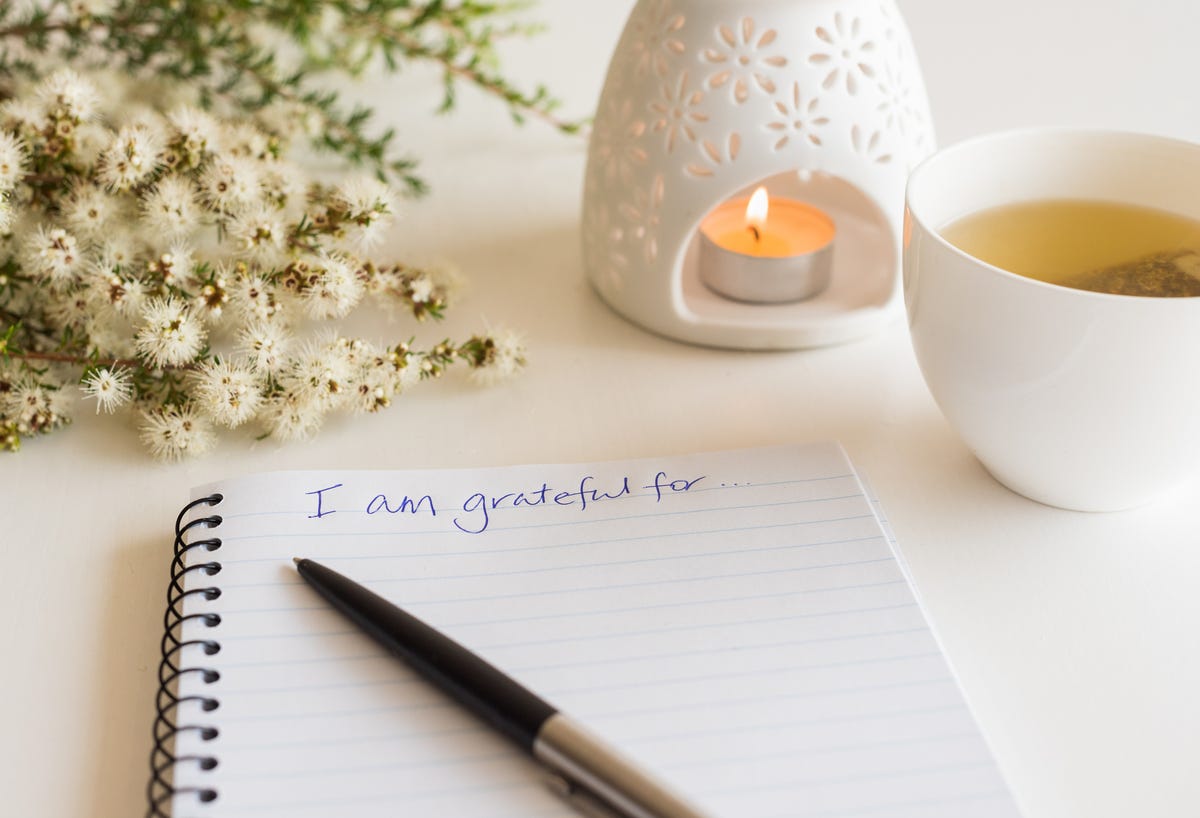[ad_1]
The holiday season is the most festive and magical time of the year. It invites us to connect with the people we love, reflect on the past year and practice gratitude for the learnings and experiences that have shaped us into who we are. However, practicing gratitude shouldn’t be reserved only for the holidays — practicing in your everyday life can improve your mental health.

Ahead, we’ll discuss why being grateful is good for you and give you some tips on how to be more grateful.
For more mental health tips, check out these tips to boost your productivity and how to cope with social anxiety.
Why is being grateful good for your mental health?
Showing gratitude and having an overall positive outlook in life can just make you feel like a happier person. But along with that positive feeling, being grateful can have real, tangible effects on your physical and mental health. See what gratitude can do for you.
- Reduces stress: Gratitude has been proven to reduce stress, according to the North Dakota Department of Behavioral Health Human Services. Feelings of gratitude trigger your brain to release dopamine and serotonin, both chemicals that boost your mood. If your mood is improved, you’re less likely to feel stressed.
- Boosts mood: For the same reason gratitude reduces stress, it boosts your mood because of the serotonin and dopamine released when you express gratitude.
- Lowers depression symptoms: Studies have linked people who feel more gratitude with fewer symptoms of depression. Practicing gratitude has even been explored as a method of treatment for depression symptoms.
- Improves interpersonal relationships: When you outwardly express your gratitude to people, it can improve your relationship with them because they’ve become aware of your appreciation. While expressing those feelings is not always easy, it can improve friendships and romantic relationships by clarifying your feelings.
- Better sleep: According to the Mayo Clinic, showing gratitude may even improve your sleep. With improved sleep, you can also take care of your overall health, as sleep is an important part of a healthy lifestyle.
Tips to get started on being more grateful
These are our tried-and-true tips on welcoming more gratitude into our lives.
Start a gratitude journal (and keep up with it)
One way to show more gratitude is to write it down every day. Start a gratitude journal to document what you’re grateful for. This can be any book or even on one of your devices. There are no rules on where you write! When you’re getting started, you might want to keep your journal handy and write things down throughout the day as you think of them, and as you get more used to soaking in your gratitude, you can write it all down at the end or beginning of the day.
With a gratitude journal, don’t be afraid to write down each and every little thing you’re grateful for. It can be as simple as being grateful that you woke up that morning and got out of bed, because for some people, that’s not possible. Be grateful that you have a meal for breakfast, a meal for lunch and a meal for dinner. Write down your gratitude for your transportation to work and that you have a job. These are things that we’re so used to that we often forget to be grateful for them. Write them down so you can see just how much you have to be grateful for.

natalie_board/Getty Images
Use visual reminders
One of the best ways to bring more gratitude into your life is to keep it in sight. A great way to do this is to write yourself notes and keep them around your house. Take a Post-It and write a gratitude reminder on it and stick it on the mirror in your bathroom. Much like positive affirmations, these notes can remind you to show gratitude.
Another way to do this is to set a reminder on your phone for various points in the day to embrace gratitude. You could set a reminder midday to remind yourself to write in your gratitude journal, another reminder to think about what you’re grateful for and yet another reminder to tell someone what you’re grateful for. All of these things will make you think about gratitude more, and if you’re thinking about it more, you’re likely to continue the grateful feelings.
Work to reframe negative thinking
The first step in reframing negative thoughts is identifying the thoughts and why they’re happening. Negative thoughts can include constant pessimism (where you always see the downside in things), blaming yourself for everything or assuming the worst outcome will always happen. You will also want to identify the situations you’re in when these negative thoughts happen. Is it when you’re around a certain group of people? Is it when you’re at work? Once you’ve identified what’s happening, you can work to reframe those thoughts into more positive ones.
It’s OK to work slowly on this one. For example, if you’re always blaming yourself for work and assuming the worst, start by targeting one thing, like the blame. Rather than blame yourself for anything that doesn’t go according to plan, help yourself see what you did right. If a project wasn’t a 100% success, identify the things you did right and explain to yourself how you can improve — all with a positive spin. Then work from there.
Make time for self-reflection
Much of what we’ve previously discussed falls into the bucket of “self-reflection.” Your gratitude journal, positive thinking and helpful reminders are all ways of reflecting on the good stuff in your life. These are important things to make time for to increase your mental capacity for gratitude. But there’s even more you can do on the self-reflection front.
Self-reflection also includes a variety of ways of bringing peace to your mind. Meditation and breathing exercises can both help you recenter yourself and bring positivity and gratitude to the forefront of your thoughts
At the end of the day, whatever you do for self-reflection, the purpose is to make time to really think about the things and people you have in your life that you’re grateful for. Once it’s become a routine, it’ll probably be easier to think about your gratitude without actually telling yourself to think about it.
Share your gratitude
There’s something to be said for sharing your joy with those around you. If you’re feeling particularly grateful, spread the word. If you’re feeling grateful for your friends, tell them that. This can strengthen your bond and improve their mood, especially if they’ve been feeling down or feeling doubt in themselves. It’s always nice to know that your loved ones appreciate you, so don’t be shy about telling them that you’re thankful for them every day.
The bottom line
Most likely, you feel grateful for things in life, but there are probably even more things to feel grateful for and even more ways to openly show gratitude. Sharing gratitude with people around you and surrounding yourself with gratitude can improve your health and make you an overall happier person. It’s truly quite easy to be grateful, it might just take a little getting used to, as it requires intentional feelings. Now that you know how gratitude can improve your wellbeing — and how to practice gratitude — you can incorporate it into your everyday life.
The information contained in this article is for educational and informational purposes only and is not intended as health or medical advice. Always consult a physician or other qualified health provider regarding any questions you may have about a medical condition or health objectives.
[ad_2]
Source link



